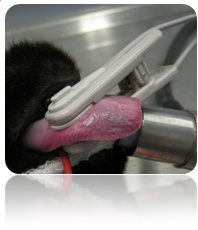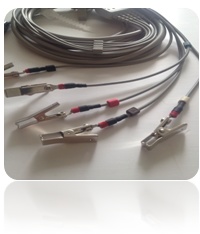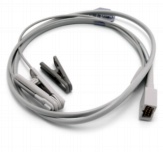Pet owners are often very anxious about veterinary procedures that involve anesthesia. This handout attempts to alleviate some of these concerns.
The word anesthesia comes from the Greek meaning "lack of sensation". Anesthesia is accomplished by administering drugs that depress nerve function. With general anesthesia, the patient is made unconscious for a short period. During this unconscious state, there is muscular relaxation and a complete loss of pain sensation. Other types of anesthesia include local anesthesia such as numbing a localized area of skin or a tooth, and spinal anesthesia, such as an epidural block, that results in anesthesia of a particular part of the body.
What are the risks of anesthesia?
There is always risk of an adverse reaction when we use any anesthetic agent, no matter whether it is for a minor, short-term sedation or for a complete general anesthesia lasting several hours. It is estimated that approximately 1 in 100,000 animals will have some sort of reaction to an anesthetic agent. These reactions may range from mild swelling at the site of injection or a mild decrease in cardiac output, to a full-blown episode of anaphylactic shock or death. However, many experts put the risk of anesthetic death as less than the risk of driving to and from the hospital to have the anesthetic procedure.
"It is estimated that approximately 1 in 100,000 animals will have some sort of reaction to an anesthetic agent."
Another potential danger associated with anesthesia arises if the cat is not properly fasted prior to anesthesia. Anesthetized patients lose the normal reflex ability to swallow; during swallowing, the epiglottis, a cartilage flap that closes over the entrance to the windpipe, prevents food or water from entering the lungs. If there is food in the stomach, the cat could vomit while under anesthesia or in the early post-anesthetic period. If vomiting occurs before the swallowing reflex occurs, the vomited material can be aspirated or enter into the lungs, causing aspiration pneumonia, a potentially life-threatening condition.
Other rare complications of anesthesia include organ system failure such as kidney liver or heart failure, visual impairment, clotting disorders and seizures. We will take every precaution to minimize these risks during your pet's anesthesia. Only when the benefits outweigh the risks will we perform anesthesia on your pet.
What can be done to minimize the risks?
"Blood tests will increase the chance of detecting a hidden problem that could prove to be life threatening."
Pre-surgical physical examination, preoperative blood and urine tests and radiographic examination may reveal clinical or sub-clinical problems. Certain medical conditions will increase the risk of having an anesthetic complication. These conditions include heart, liver or kidney disease, diabetes mellitus, anemia, dehydration, and certain infectious diseases such as heartworm disease. Blood tests will increase the chance of detecting a hidden problem that could prove to be life threatening. In older animals, chest radiographs are recommended to ensure there is no pre-existing pathology in the heart or lungs that might increase the risk of an adverse reaction.
Immediate intravenous access for emergency drug administration is one of the most important factors in the successful treatment of cardiovascular or respiratory failure in either the awake or the anesthetized patient. By placing an intravenous (IV) catheter and line before anesthesia, your veterinarian can ensure that this lifeline is already in place, should the need arise. Anesthetics, fluids and emergency drugs can be administered through the IV line.
"All general anesthesia patients should receive intravenous catheterization and fluid therapy."
Intravenous fluids help maintain blood pressure in the anesthetized patient and will replace lost fluids (during surgery, fluids are lost through evaporation from body cavity surfaces, through bleeding, and in any tissues that are being removed). Upon completion of the procedure, intravenous fluid therapy speeds the recovery process by diluting the anesthetic agents circulating in the blood stream and by enhancing their metabolism and elimination through the liver and kidneys. Patients that receive IV fluid therapy generally wake up faster than those that do not. Additionally, studies have shown that 0.9 - 2% of all patients that receive general anesthesia will develop kidney dysfunction or failure 7-14 days after anesthesia. This risk is significantly reduced in patients that receive peri-operative intravenous fluid therapy. Although 98% of all pets will have no problem, your veterinarian's goal is to eliminate that unknown 2%. For these reasons, all general anesthesia patients should receive intravenous catheterization and fluid therapy.
You should ensure that your pet's complete medical history is available to your veterinarian, especially if your pet has been seen at another veterinary clinic. Before anesthetizing your cat, your veterinarian needs to know about any medications or supplements that your cat has received in the past few weeks, any pre-existing medical conditions, any known drug reactions, the results of previous diagnostic tests, and whether the cat has undergone any anesthetic or surgical procedures in the past. Other useful information includes the pet's vaccine status and reproductive status (i.e. when was its last estrus or heat cycle).
Why do I have to sign an anesthetic consent form?
It is important that you fully understand what will happen to your pet, and that you acknowledge that you understand the risks. Usually, the form will also include consent to perform surgery or other specified diagnostic testing, and will provide an estimate of the expected costs of the procedures. In many areas, the veterinarian is required by their regulatory organization to obtain written consent from the client prior to performing anesthetic procedures.
Can you describe a typical anesthesia?
All anesthesia patients are weighed on admission and are given a thorough pre-anesthetic examination, which includes an examination of the chest, palpation of the

abdomen, and assessment of the gums (checking for hydration status and evidence of good circulatory status. After reviewing the medical history, additional diagnostics such as blood or urine testing, blood pressure, electrocardiogram (ECG) or x-rays of the chest or abdomen may be performed prior to administration of any anesthetic drugs.
"With balanced anesthesia, the patient receives a combination of sedatives and anesthetic agents that is suited to its individual needs."
In the great majority of cases, a technique called 'balanced anesthesia' is used. With balanced anesthesia, the patient receives a combination of sedatives and anesthetic agents that is suited to its individual needs. The most common combination is a pre-anesthetic sedative and analgesic combination that is administered by injection, followed by an induction agent that is also administered by injection; the anesthetized state is maintained with an anesthetic gas mixed with oxygen. In order to ensure accurate delivery of the gas anesthetic, a breathing tube, called an endotracheal tube, is inserted into the windpipe or trachea. In addition to delivering the gas to the lungs, the endotracheal tube seals off the airway so that the patient does not accidentally aspirate fluids or other foreign material into the lungs while unconscious and unable to swallow.
How do you monitor an anesthetized cat?
Anesthetic monitoring in a veterinary hospital is similar to that found in any human hospital. Below is a list of common veterinary anesthesia monitoring equipment and personnel:
"The Surgery Assistant is the most important monitor during an anesthetic procedure."
The Surgery Assistant is the most important monitor during an anesthetic procedure. This professional staff member is trained to monitor the patient throughout the entire procedure, from induction until recovery. The assistant adjusts the anesthetic levels according to the patient's vital signs and ensures that the patient remains stable throughout the procedure.
The Electrocardiogram, abbreviated as ECG (or EKG, referring to the original German term), shows the rate and pattern of the heartbeat. It will detect and show abnormal heartbeats called arrhythmias. If abnormal heartbeats are observed, the anesthetist will make appropriate changes in anesthesia and/or emergency medications.
The Heart Rate Monitor measures the number of heartbeats per minute. Heart rate must be maintained within a certain range. The depth of anesthesia and surgical stimulation can both affect heart rate. By monitoring heart rate, increases or decreases can be detected early and anesthetic adjustments made quickly, resulting in smoother anesthesia for our patients.
The Blood Pressure Monitor measures the systolic (when the heart contracts or pumps) and occasionally the diastolic (when the heart relaxes or refills) blood pressure. Coupled with other monitoring equipment, this gives detailed information on the cardiovascular status of the patient.
The Respirometer measures the number of breaths per minute.
The Core Body Temperature is monitored, especially during a prolonged surgery, by inserting a temperature probe into the esophagus or the rectum. Either too low or too high a body temperature can cause dangerous complications. Maintenance of normal body temperature is especially important in small or pediatric patients.
Pulse Oximetry may be used to monitor the amount of oxygen in the patient's blood (Sp02) and the pulse rate. This instrument should always be used in conjunction with other pieces of monitoring equipment.
The End-tidal C02 Monitor is often used in conjunction with a pulse oximeter. This device measures the amount of expired C02 and helps determine if the patient is receiving adequate oxygen during anesthesia.

How long will it take my cat to recover from anesthesia?
With today's anesthetics, many of which are reversible, your pet should be almost completely normal by the time of discharge, although many pets will sleep more for twelve to twenty-four hours after anesthesia. If your pet appears to be unusually sluggish or you cannot arouse him/her easily, contact the hospital immediately to receive specific advice.





